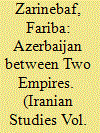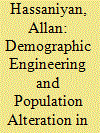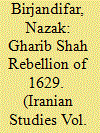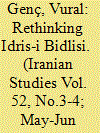|
|
|
Sort Order |
|
|
|
Items / Page
|
|
|
|
|
|
|
| Srl | Item |
| 1 |
ID:
168970


|
|
|
|
|
| Summary/Abstract |
The first part of the paper examines the evolution and transformation of Safavid ideology in the context of confessional changes and the role of Turkoman tribes in the Safavid social movement in the Ottoman‒Iranian borderland. The second part examines the impact of Ottoman‒Safavid wars and religious rivalry on the society and economy of Azerbaijan from the sixteenth to the eighteenth centuries.
|
|
|
|
|
|
|
|
|
|
|
|
|
|
|
|
| 2 |
ID:
168982


|
|
|
|
|
| Summary/Abstract |
This article presents two hitherto unstudied compilations of verses from the Bustān of Saʿdī. Both circulated in the Persianate world in the fifteenth and sixteenth centuries. The article provides an analysis of the compilations’ content as well as their relation to the complete Bustān. By highlighting certain stories and themes at the expense of others, and by ordering these passages in a way that differs from the complete Bustān, each compilation transforms Saʿdī’s text into a shorter, more homogenous composition, with distinct formal, thematic, and generic qualities. The shorter compilation presents a series of aphorisms, forming a mirror for princes. The longer one offers a selection of stories and lessons and emphasizes mystical themes, including aspects of Sufi erotic theology. This article also investigates the manuscript copies of these compilations, revealing their use and transmission in Iran, Turkey, and Central Asia between 1470 and 1550.
|
|
|
|
|
|
|
|
|
|
|
|
|
|
|
|
| 3 |
ID:
167218


|
|
|
|
|
| Summary/Abstract |
Studying the Iranian Kurdish question reveals the importance of the geopolitical location of the Kurdish region, which has left a massive impact on the framework and capability of the contemporary Kurdish national movement. Aware of this fact, different ruling regimes of Iran, considering territorial threats associated with the Kurdish nationalistic movement, implemented different policies of systematic “demographic engineering,” aimed at reducing the capability of the Kurdish claim for autonomy. Some aspects of the policy of demographic engineering implemented during the Safavid and the Pahlavi dynasties have been examined. Based on this, the article argues that the geopolitical location of the Kurdish region, as a buffer zone between the Ottoman and Safavid dynasties, has diminished and continues to undermine the capability of the Kurdish struggle for autonomy in Iran.
|
|
|
|
|
|
|
|
|
|
|
|
|
|
|
|
| 4 |
ID:
186909


|
|
|
|
|
| Summary/Abstract |
The Gharib Shah Rebellion erupted in Gilan in 1629, shortly after the death of Shah ʿAbbas I and the ascension of Shah Safi I to the throne. A close engagement with Gilani chronicles reveals the uprising was motivated by anti-Safavid sentiment and a desire to restore autonomous rule in Gilan. The Gharib Shah Rebellion is best understood in the context of the series of post-conquest rebellions in Gilan, which had both political and economic motivations. It marked the final attempt to regain autonomy from the Safavids, nearly forty years after their conquest of the region. While messianism was not completely absent in Gilan in this period, it was not a factor in this rebellion and its role, in general, has been over-emphasized.
|
|
|
|
|
|
|
|
|
|
|
|
|
|
|
|
| 5 |
ID:
168973


|
|
|
|
|
| Summary/Abstract |
A bureaucrat and historian of Iranian origin, Idris-i Bidlisi (b. Ray/Iran 1457–d. Istanbul 1520), is undoubtedly one of the most original and important intellectual figures in the Ottoman‒Iranian borderland in the sixteenth century. He lived in a very turbulent period and established different relationships with Iranian and Ottoman dynasties at the end of the fifteenth century and at the beginning of the sixteenth century. He and his works have been the focus of long-standing historical debates in Turkey that have continued to the present day. Until now, most modern scholarly works on Bidlisi have failed to provide a proper, in-depth textual and historical analysis. As a result, such modern works have come to present a skewed, romanticized image of Bidlisi, largely detached from the nature and dynamics of the historical context in which Bidlisi lived and evolved as an intellectual and writer. This paper provides a realistic appraisal of Bidlisi and discusses the shortcomings of modern historiography on him. By looking at Bidlisi and his corpus, and more specifically at the ways in which the latter was shaped by Bidlisi’s patronage relationships, the paper aims to open up a window into Bidlisi’s evolving mindset and worldview. In other words, through an in-depth analysis of his corpus and new archival sources the paper strives to unveil the intellectual life and career of an Iranian bureaucrat and historian positioned between Ottoman‒Iranian borderland and provide a glimpse into the nature of patronage in the sixteenth century.
|
|
|
|
|
|
|
|
|
|
|
|
|
|
|
|
|
|
|
|
|